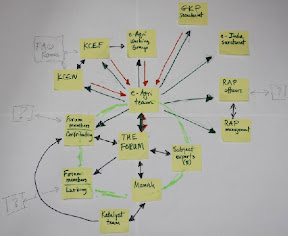
One of the major challenges was deciding whether to map individuals, organizations, or some combination of both. In the end I have a combination, a combination that changed as I progressed through the assignment. Ultimately I chose to go with more organizational groups and fewer individuals mainly to make mapping different lines of communication a simpler process. But then this led to questions, and more questions by a colleague and facilitator.
1) What about the individuals & related communication flows we know exist, but cannot "see" and thus cannot map?
2) What are the pros, cons of mapping individuals versus mapping organizations/groups?
3) What happens to the lines in a map when an individual moves in/out of a particular position within an organization?
I think the answer to question 1 is that these can be elucidated by different means, so part of the exercise is determining if it is necessary/worthwhile to make the effort.
Points 2 and 3 are interlinked. But I'm having a hard time rationalizing the individual/organization relationship. I think (but need some help on this) that it's the individual that is responsible for the communication/KS so that the individual is key. And that individuals moving from position to position (inter- or intra-organizationally) move their communication lines with them, but by necessity evolve those lines based on their new environment. Thus the organization is the environment ... enabling or otherwise. Hmm....
4 comments:
I think you are getting right into the heart of the matter, Michael. And surfacing that we can neither assume the individual from the organization, nor divorce our view of the individual from the organization.
It is a system. That's the central issue. We tend to atomize so much of our KM/KS work that we lose sight of the fact that all these things interact.
So for me, the prime learning I received from your hard work is to ask myself the question about the interlinkage between an individual in the network and the organization they work within/for. How does that influence the KS goals and purpose? How can that relationship be postively leveraged?
Does that make ANY sense? (I make sense by "speaking out loud and sometimes it takes a few iteration and improvement from others!)
Yes Nancy, it makes very good sense. The individual/organization relationship is paralleled by many other things, so conceptually it's easy to bend my mind around this one. Not so easy is developing answers to your questions ... I guess that's what keeps us interested in this field!
Hi Michael,
In mapping our network, we had a similar experience of groups and/ or individuals. However, this was a problem to us since we found it worthwhile to pull out some individual units from general groups. Examples include; ministries of health, ministries of agriculture, local public, international public, SRO's and other SRO's (SROs=Sub Regional Organizations).
It was imperative for us to do so because there exist unique interactions between these units and other groups. So we could not afford placing them in the general groups of public sectors or sub-regional organizations. With the latter, separating the two was important since one category is at a lower lever than the other. So, I see no harm mapping individuals and groups.
Hi Agnes. I do agree with you that it's necessary to map some individuals and also ok to keep others in group represented by all or part of an organization. Sometimes the choice of how to do this isn't so clear (at least not to me!) but that is also what makes this a learning process. :-)
Post a Comment